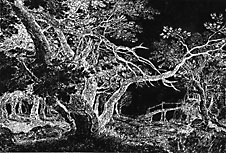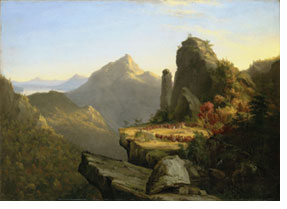Enhancing the Museum Experience
Education Team Encourages Active
Learning in Renovated
Scaife Galleries
By Ellen S. Wilson
If Marilyn Russell has her way, visitors to the newly
renovated Scaife Galleries will be spending less time
walking and more time sitting, writing, reading, and
discussing. Russell, curator of education for Carnegie
Museum of Art, says that the physical changes to the
galleries have allowed the education team to implement
more programs that promote active learning. “Rather
than have works of art wash over the visitor, we want
the art to have an impact,” says Russell.
With 70 percent more artwork on display than before
the renovations, the Scaife Galleries can be somewhat
intimidating for the uninitiated. Russell says that
visitors to the galleries range from casual tourists
to art historians and from visual artists to parents
with young children. Each brings a different perspective
to the museum experience.
The education department has explored ways to create
an active learning environment for every visitor, especially
those who are less familiar with art history and art
making. “The Museum has been experimenting with
ways to invigorate the casual gallery experience with
active learning strategies,” says Russell.
For example, visitors can expect to see the return
of writing stations that were an integral part of the
Panopticon exhibition. The writing stations—small
podiums with a quote from an artist and an opportunity
for visitors to respond to the quote and the artwork
on view—challenge visitors to think about what
they are seeing. Visitors are encouraged to write their
thoughts on small cards and slip them into a little
notebook. “It frequently turns into a written
conversation with other people,” says Russell. “By
reading other people’s comments and recording
their own observations, visitors participate in a kind
of community forum that encourages reflection and a
more active role in creating their own museum experience.
Russell also says that there are many more explanatory
labels next to works of art in the new galleries providing
a great deal of contextual information, “but
providing that information alone is not enough. We
want to respond to our visitors’ curiosity about
the artists, the techniques, and the cultural and historical
context in which the work of art was created,” says
Russell. “But we know from research on learning
and numerous visitor studies that the most meaningful
experiences with works of art are those that allow
visitors to find a personal connection.”
Comfortable couches, richly colored walls, and groupings
of artworks make the new setting warmer and more welcoming,
encouraging visitors to linger and take time for reflection.
A large selection of art books is available at seating
areas throughout the galleries, so that visitors can
further explore artists, works, and styles that interest
them.
The audio guide is another resource for visitors that
was introduced during the Panopticon exhibition. Available
from the admission desk for a small fee, the audio
guide includes recorded information on more than 100
works of art that can be viewed in any order—with
a recommended short tour of 24 key works for those
looking for a structured path through the galleries,
or who have less time. The audio entries are designed
to provide both factual information (about artists,
techniques, the creative process) and other interesting
commentary that may make the art more meaningful. Narration
is provided by a variety of speakers; in some cases
by the artist, the artist’s family members, experts
in a related area, curators, and, for works of greatest
interest to children, by “Art Cat,” the
museum’s mascot for children’s programs.
Russell also encourages visitors to take advantage
of the daily free gallery talks conducted by Museum
of Art docents that combine information with lively
conversation and the chance to ask questions and compare
points of view.
For visitors who like to learn experientially, the
ARTventures program continues to provide art-making
opportunities in various galleries. “Parents
especially appreciate ARTventures,” says Russell. “Often,
they are unsure about how to create a successful gallery
visit for their children so we provide the tools with
a scavenger search and hands-on art projects.” The
ARTventures activity and location changes monthly and
is available on a drop-in basis every weekend.
Russell credits her talented staff for the visitor-centered quality apparent
in the Scaife galleries. By providing additional resources, Russell believes
visitors will be able to connect better with artwork, asking such questions as: “What
do I find interesting about this artwork?” “What might it have been
like to experience it in its own time?” “How is it relevant to my
life?” “Why is this work considered a great work of art?” Russell
believes it is the responsibility of the Museum to help visitors understand the
works within the galleries, even those that are difficult. “We want viewers
to be curious, even challenged, but not puzzled. It is our obligation to provide
the tools necessary to help them respond to this world-class collection in ways
that are enjoyable and meaningful.” Russell adds, “When you encounter
something new in a work of art and connect it to something you already know in
a way that enriches your understanding of the world, that results in a lasting
impact. It’s the definition of learning.”
Recent Acquisition:
Ugo Rondinone
No.249 – EINUNDZWANZIGSTERSEPTEMBERZWEIT – AUSENDUNDEINS
2001, ink on paper  Ugo
Rondinone Ugo
Rondinone
No.249 – EINUNDZWANZIGSTERSEPTEMBERZWEIT – AUSENDUNDEINS
2001, ink on paper. Courtesy Mathew Marks Gallery,
New York. A.W. Mellon Aquisition Endowment Fund.
The sublimely detailed ink drawings by Ugo Rondinone
depict romantic views of alpine landscapes, lush
forests, and well-worn paths, putting them, as Curator
of Contemporary Art Laura Hoptman says, “squarely
within the tradition of the early nineteenth-century
German Wandermaler, or itinerant painter.” And
yet, as Hoptman explains in an article on Rondinone
in Parkett, “Despite their source in plein-air
sketches, these works are scrupulously realistic
renderings, not of a specific landscape, but of the
landscape in art. Rendered in grisaille, and carefully
numbered and dated to the day not when the scene
was purportedly captured in a preparatory drawing,
but when it was inked on a wall, there is no mistaking
them for a window onto the world at large.”
Born in Switzerland in 1963, Rondinone first attracted
attention in Europe in the 1990s for installations
that combined actors, sound, painting, photography,
and video. His works tend to address the conflict—or
the intersection—between artifice and reality,
and his own body and head often figure in videos
or computer-altered images. Rondinone studied in
Vienna from 1986 to 1990, and currently lives in
New York. n
UPDATE:

“Exhibitions
like these take on a particular kind of time-tested
rhythm,” says Curator of Contemporary Art
Laura Hoptman of the upcoming Carnegie International.
Set to open on October 9, 2004, the museum’s
preparation for the exhibition, she says, is right
on schedule. Just back from Helsinki, Stockholm,
and London, and after a recent trip to Istanbul,
Hoptman is not yet ready to release the list of
artists to be included, but says the exhibition
will tell a story “in the broadest sense,” dealing
with issues that people confront every day.
The last International, says Hoptman, was high profile,
but there is a new crop of artists who are unfamiliar
with Pittsburgh and its recurring landmark exhibition. “If
you go to a country where an artist has recently
participated in it, they know the International,” she
says. “But everyone knows who Andrew Carnegie
was.”
To pull the exhibition together, Hoptman, along with
Assistant Curator Elizabeth Thomas and Secretary
Sara Hromack, set up meetings in advance in areas
where Hoptman noticed interesting activity or exhibitions.
She visited artists’ studios when she could
and met with curators at other institutions for direction
and advice. Because many artists today work with
video or large-scale installation art, it was often
challenging to find a way to see their current projects.
“
You establish a relationship with the artist and
see what they’re doing,” she says of
this time-consuming process. “There is a necessary
lack of spontaneity. The museum has to prepare,” both
physically and financially. To that end, the Friends
of the Carnegie International, a group of collectors
and other art lovers chaired by Milton and Sheila
Fine of Pittsburgh and Jill and Peter Kraus of New
York, has been formed to support the exhibition.
Watch for more news about the upcoming Carnegie
International—including
the artists who will be featured in the exhibition
this fall—in future issues of CARNEGIE magazine.
Three Exhibitions, One Focus
Landscape Paintings, Prints, and Photographs Portray
Early 19th Century
Hudson
River School: Masterworks from the Wadsworth
Atheneum Museum of Art, Heinz Galleries ; The
Romantic Print in Britain, Works on Paper
Gallery; Eloquent Vistas: The Art of
Nineteenth Century American Landscape Photographers,
Heinz Galleries
 Thomas
Cole, American, 1801-1848, Scene from The Last
of the Mohicans: Cora Kneeling at the Feet of Tamenund, 1827, oil on canvas, The Wadsworth Atheneum Museum
of Art. Thomas
Cole, American, 1801-1848, Scene from The Last
of the Mohicans: Cora Kneeling at the Feet of Tamenund, 1827, oil on canvas, The Wadsworth Atheneum Museum
of Art.
America’s first school of landscape painters
emerged between 1815 and 1875 and was inspired by
the Hudson River area, Niagara Falls, the Connecticut
River Valley, and all the natural wonders found in
abundance in what was then considered the New World.
The Wadsworth Atheneum’s collection of Hudson
River School paintings, begun by founder Daniel
Wadsworth, is arguably the best in the world, boasting
13 paintings
by Thomas Cole and 11 paintings by Frederic Church.
Cole is traditionally considered one of the original
and most influential painters of the Hudson River
School, using his art as a moral platform as well
as an opportunity to portray the unspoiled American
wilderness.
Wadsworth, an early patron of both Cole and Church,
introduced the two artists when Church was 17
years old, and Cole immediately made the young
painter
his apprentice. During the Civil War, Church
advised Elizabeth Hart Jarvis Colt as she assembled
an impressive
collection of works by such artists as Albert
Beirstadt, William Bradford, John Kensett, and
Sanford Gifford,
among others. Later, Colt became a major donor
to the Atheneum. This exhibition will feature
55 works
by Hudson River School artists and will be accompanied
by a catalogue.
 John
Raphael Smith (1752-1812) John
Raphael Smith (1752-1812)
after George Morland (1763-1804)
African Hospitality, 1791,
mezzotint, printed in color, published state
Yale Center for British Art.
Two
complementary exhibitions will be presented
in conjunction with Masterworks from the Wadsworth
Atheneum
Museum of Art. The Romantic Print in Britain
is
drawn from the Paul Mellon collection of British
prints
at the Yale Center for British Art in New Haven,
Connecticut. Set in the same time period, this
exhibition considers the Romantic preoccupation
in England with
the natural and manufactured worlds, and deals
with such issues as technological change, national
identity,
and humanity’s relationship with the environment—subjects
that concerned Turner and Constable and are
still relevant today. The exhibition will feature
printmaking
tools and plates, as well as rare progress
proofs tracing the evolution of specific images.
 Platt
D. Babbitt, American, ?-1879, Platt
D. Babbitt, American, ?-1879,
Tourists Viewing Niagara Falls from Prospect
Point, c. 1855 daguerreotype with applied color.
George Eastman House.
At
the same time, the relatively new art of photography
was capturing the unfolding and often dangerous
American frontier. Organized by the George
Eastman House in
Rochester, New York, Eloquent Vistas: The Art
of Nineteenth Century American Landscape Photographers
will include works by Timothy O’Sullivan,
Alexander Gardner, William Henry Jackson, and
Carleton Watkins.
Together, these three exhibitions will provide
an insightful examination of a tumultuous period
in
British and American history.
Back to Contents |